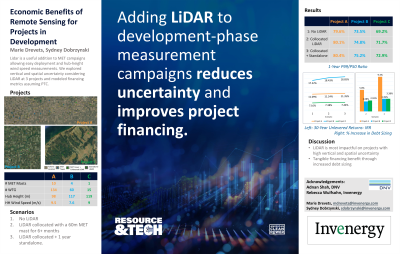Back

Economic Benefits of Remote Sensing for Projects in Development
Tuesday, October 1, 2024
5:00 PM – 6:00 PM MST
Location: Regency D


Marie Drevets
Project Engineer
Invenergy
Poster Presenter(s)
Presentation Description: Remote sensing device (RSD) incorporation into measurement campaigns combats increased vertical and spatial extrapolation uncertainties as projects grow larger and turbine hub heights grow taller. These lower uncertainty values yield a larger P99/P50 ratio, which in turn, drastically improves financing costs by reducing lender-perceived risk.
Our first case study highlights how a standalone RSD characterizes wind flow in a large project area and reduces spatial uncertainty. Project 1 covers 152,000 acres across 2 counties and originally had six 60m met masts located throughout. Following the verification process, the device was moved to another area of the site with poor coverage from existing met masts. By deploying it as a standalone measurement device, there was a decrease in spatial uncertainty without installing additional masts.
The second case study demonstrates the benefit of utilizing an RSD to decrease vertical extrapolation uncertainty and verify shear and hub height wind speed. Project 2 includes a smaller turbine layout with a hub height of ~120m and one 60m met mast. Without an RSD deployed, the measurement campaign may misrepresent shear and therefore hub height wind speed, putting our energy yield assessment at risk.
In both cases, decreasing uncertainty in our energy estimates both limits the project developer's risk in any contracted energy yield and provides an economic advantage. With each scenario studied, we will share how RSDs reduce uncertainty from a standard MET campaign and result in tangible benefits to project financing.
Our first case study highlights how a standalone RSD characterizes wind flow in a large project area and reduces spatial uncertainty. Project 1 covers 152,000 acres across 2 counties and originally had six 60m met masts located throughout. Following the verification process, the device was moved to another area of the site with poor coverage from existing met masts. By deploying it as a standalone measurement device, there was a decrease in spatial uncertainty without installing additional masts.
The second case study demonstrates the benefit of utilizing an RSD to decrease vertical extrapolation uncertainty and verify shear and hub height wind speed. Project 2 includes a smaller turbine layout with a hub height of ~120m and one 60m met mast. Without an RSD deployed, the measurement campaign may misrepresent shear and therefore hub height wind speed, putting our energy yield assessment at risk.
In both cases, decreasing uncertainty in our energy estimates both limits the project developer's risk in any contracted energy yield and provides an economic advantage. With each scenario studied, we will share how RSDs reduce uncertainty from a standard MET campaign and result in tangible benefits to project financing.
